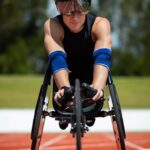In this powerful article, disabled athlete and advocate Jaden Movold shares his lived experiences of ableism in sport. These aren’t isolated incidents – they’re patterns disabled young people face again and again. They won’t change unless we do. Jaden shows us how.
An estimated 17 percent of people in New Zealand are disabled – that’s 1 in 6 of us. Disabled people tend to experience various forms of discrimination and exclusion in everyday life, from school classrooms to opportunities for paid work, through to participation in the community.
Sport is a place that should uplift and empower disabled young people. But the reality is, young disabled people miss out on opportunities to play sport far more than their non-disabled friends.
Why is this the case?
Young disabled people don’t just face barriers to being active, they face signals that they don’t belong.
From gyms with steps and no ramps, to sports halls where loud echoes make it hard to focus, to coaches who freeze when inclusion calls for creativity. The barriers aren’t always physical. Sometimes they’re the quiet pauses, the awkward glances, the “we’re just not sure how to include you.”
I’ve lived this.
I’ve been told, “You can train with us, but you can’t race.”
I’ve crossed finish lines and watched every other kid get a ribbon, except me.
I’ve earned my place in a swimming final, only to be pulled aside and told, without reason, “You won’t be competing.”
These weren’t one-offs. They weren’t misunderstandings.
They were decisions, unspoken, unchallenged, that told me I didn’t count.
These barriers don’t just arise from physical infrastructure, but from a deeper set of assumptions about who belongs in sport. These assumptions form the basis of ableism.
Like racism and sexism, ableism is a form of discrimination. It stems from stereotypes and unconscious beliefs about what disabled people can or can’t do. And in sport, it’s often subtle and systemic, embedded in well-meaning practices and everyday decisions.
Drawing on insights from coaches, practitioners and stakeholders across the play, active recreation and sport system, researchers from Sport NZ and Massey University developed the Red Cards for Ableism comic to support coaches in recognising these hidden forms of exclusion.
“The barriers aren’t always physical. Sometimes they’re the quiet pauses, the awkward glances, people saying ‘we’re just not sure how to include you.’”
Ableism can show up in many ways:
- When clubs prioritise “mainstream” sport and sideline disability inclusion.
- When disabled coaches, leaders and officials are missing from decision-making.
- When access is treated as an afterthought.
- When disabled athletes are expected to adapt to existing systems, rather than systems adapting to them.
- When “independence” is praised over interdependence.
- When success is measured by non-disabled standards.
- When decisions are made about us, without us.
For me, it sounded like:
- “It’s just not fair on the others.”
- “We don’t want you to get hurt.”
- “We’re not sure how to include you.”
- “You can’t compete, but you can cheer your friends on.”
- “The rules are the rules. There’s nothing we can do.”
These weren’t said with bad intentions, but they still sent the same message: you can be here, as long as you don’t change anything.
And these patterns hurt. Not just by limiting access, but by shaping identity. They chip away at confidence and sense of belonging. Over time, disabled people begin to internalise these exclusions, wondering if they’re the problem.
It shapes how loudly you speak, how much of yourself you bring, and how much you’re willing to risk being fully seen.
But I’ve also seen what inclusion looks like. In high school, a teacher sat down with me and asked how I wanted to play basketball. We worked together to adapt the court and team tactics. I wasn’t just included, I was part of the solution. That moment stuck with me too.
Even well-meaning people and programmes can reinforce ableism if they don’t critically reflect. Inclusion that requires us to conform to existing systems isn’t real inclusion. And tolerance is not the same as leadership.
Only 3.4% of the sport sector workforce identifies as disabled. This is a reflection of structural exclusion. We need more disabled people at all levels, bringing their lived expertise into decision-making.
So what can we do?
We need coaches, teachers and sport leaders to pause and reflect:
- Who is this session really designed for?
- What assumptions am I making about ability?
- How can I invite disabled athletes to shape the environment?
- What would it look like to co-create sport spaces that begin with their needs?
Challenging ableism means recognising that disability is not a deficit. It’s a form of diversity. And like all forms of diversity, it deserves space, voice, and respect.
This isn’t about special treatment. It’s about equity. It’s about building systems that reflect every athlete’s humanity, potential, and dignity, and that value interdependence, flexibility, and connection just as much as performance.
This isn’t just about naming what’s broken. It’s about building something better. Let’s move beyond surface-level inclusion and into the deeper work of redesigning sport with disabled people, from the ground up.
Because sport, at its best, is about pushing limits, physically, mentally and socially. And real inclusion pushes systems in the same way.
The true test of any sport system is not in medals or records. It’s in whether every disabled person, regardless of their body or mind, is welcomed, supported and celebrated.







